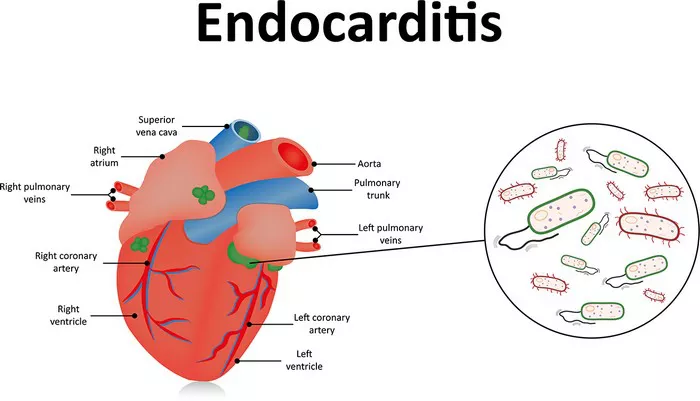Endocarditis is a serious infection of the inner lining of the heart chambers and valves. It occurs when bacteria or other germs enter the bloodstream and attach to damaged areas of the heart.
Recognizing the warning signs of endocarditis is critical. Early diagnosis and treatment can prevent severe complications, including heart failure, stroke, and even death. This article explains the main warning signs of endocarditis in detail. It covers symptoms, clinical signs, and diagnostic clues that help healthcare providers detect this condition early.
Understanding Endocarditis
Definition and Causes
Endocarditis refers to inflammation of the endocardium, the inner lining of the heart. It often involves the heart valves. Most cases result from bacterial infection, but fungi and other microorganisms can also be causes.
The infection usually begins when bacteria enter the bloodstream through everyday activities, medical procedures, or infections elsewhere in the body.
Types of Endocarditis
Endocarditis can be classified as:
Acute Endocarditis: Rapid onset and severe symptoms, often caused by aggressive bacteria like Staphylococcus aureus.
Subacute or Chronic Endocarditis: Slower development, with less dramatic symptoms, often caused by less aggressive bacteria.
Common Warning Signs of Endocarditis
Fever and Chills
Fever is the most common symptom. It results from the body’s immune response to infection. Patients often report persistent or intermittent fever that lasts days or weeks.
Chills often accompany fever and may be severe, reflecting systemic infection.
Heart Murmurs
A new or changed heart murmur is an important clinical sign. It occurs because the infection damages heart valves, altering blood flow sounds.
Healthcare providers listen for murmurs during physical exams, especially if infection is suspected.
Fatigue and Weakness
Patients commonly feel tired and weak due to prolonged infection and systemic inflammation. These symptoms may develop gradually and can be nonspecific.
Shortness of Breath
Endocarditis can damage heart valves, leading to heart failure. This causes fluid buildup in the lungs and shortness of breath, especially during physical activity or when lying down.
Night Sweats
Many patients experience excessive sweating at night. This symptom is a sign of systemic infection and inflammation.
Less Common but Important Warning Signs
Petechiae
Small, pinpoint, red or purple spots may appear on the skin, mouth, or eyes. These spots are caused by tiny blood vessel bleeding due to damaged vessels or immune complex deposits.
Osler Nodes
These are painful, red or purple nodules found on the fingers and toes. Osler nodes result from immune complex deposition in the skin and are a classic sign of endocarditis.
Janeway Lesions
Janeway lesions are painless, flat red spots on the palms and soles. Unlike Osler nodes, they are caused by septic emboli and indicate the spread of infection.
Splinter Hemorrhages
These are thin, dark lines under the fingernails or toenails. They result from small clots or bleeding under the nails and can be a sign of endocarditis.
Enlarged Spleen
Spleen enlargement may occur due to immune system activation and infection. It can cause discomfort or pain in the left upper abdomen.
Weight Loss
Unintended weight loss can result from chronic infection and poor appetite.
Neurological and Other Systemic Symptoms
Stroke and Neurological Deficits
In some cases, infected clots can break off and travel to the brain, causing strokes. This leads to sudden weakness, numbness, speech difficulties, or confusion.
Joint and Muscle Pain
Patients may experience muscle aches or joint pain due to immune response and inflammation.
Kidney Problems
Kidney damage or inflammation may occur, causing blood in the urine or reduced kidney function.
Diagnostic Clues Based on Warning Signs
Blood Cultures
Identifying bacteria in the blood is critical for confirming endocarditis. Blood cultures are drawn when infection is suspected based on warning signs.
Echocardiography
This imaging test detects vegetations or abnormalities on heart valves. It is key for diagnosis after warning signs appear.
Laboratory Tests
Elevated inflammatory markers like ESR and CRP support the diagnosis. Anemia and abnormal urine tests may also be present.
When to Seek Medical Attention
Anyone with risk factors such as a history of heart valve disease or recent invasive procedures who develops warning signs like fever and unexplained fatigue should seek prompt evaluation.
Conclusion
Endocarditis is a life-threatening infection. Knowing the warning signs helps in early detection and treatment.
Common symptoms include fever, heart murmurs, fatigue, and shortness of breath. Less common signs like Osler nodes and Janeway lesions are also important clues. If you suspect endocarditis, timely medical evaluation is essential to prevent serious complications.
Related topics:


